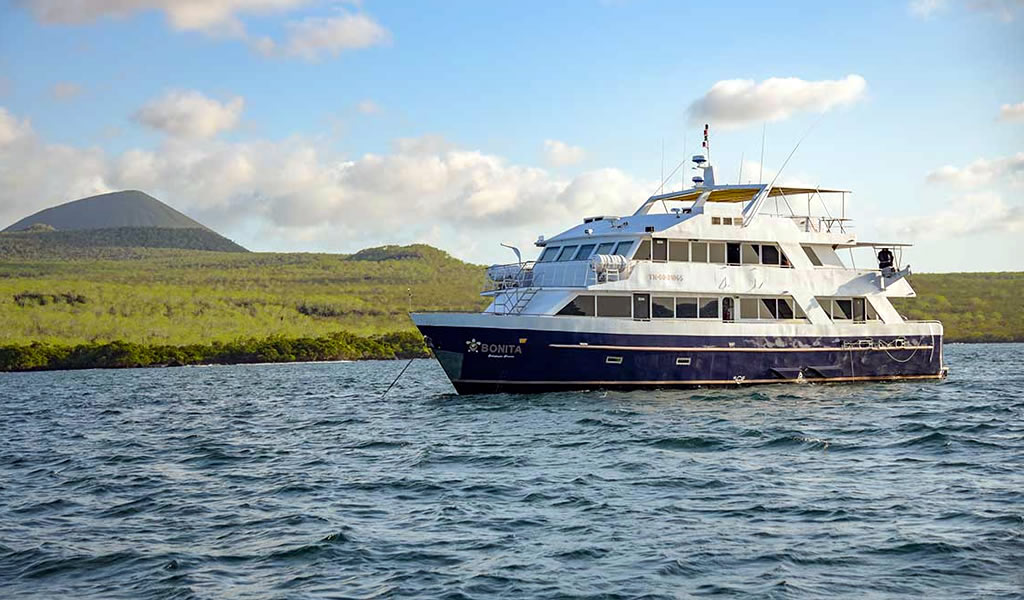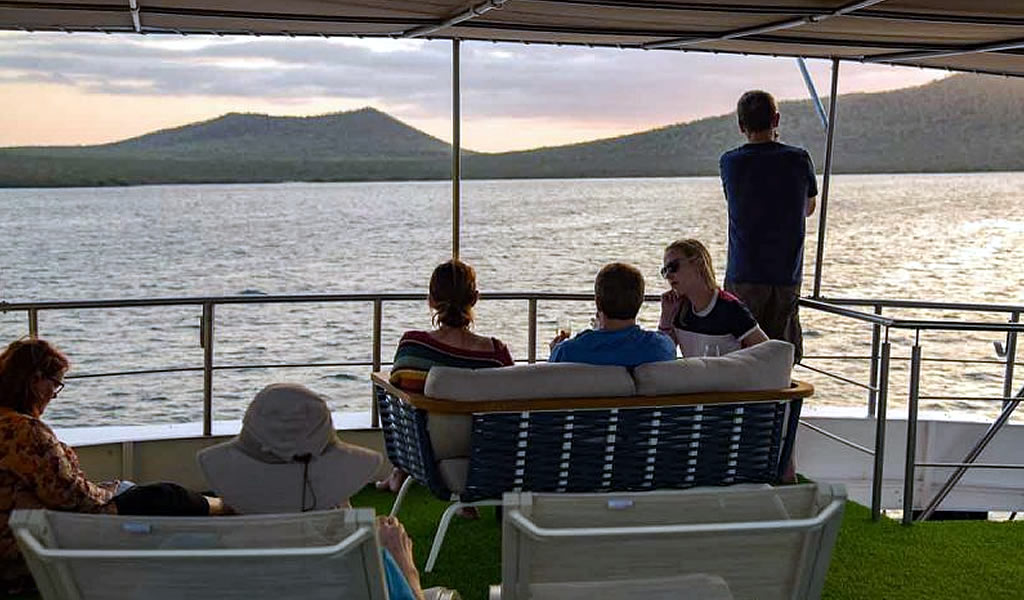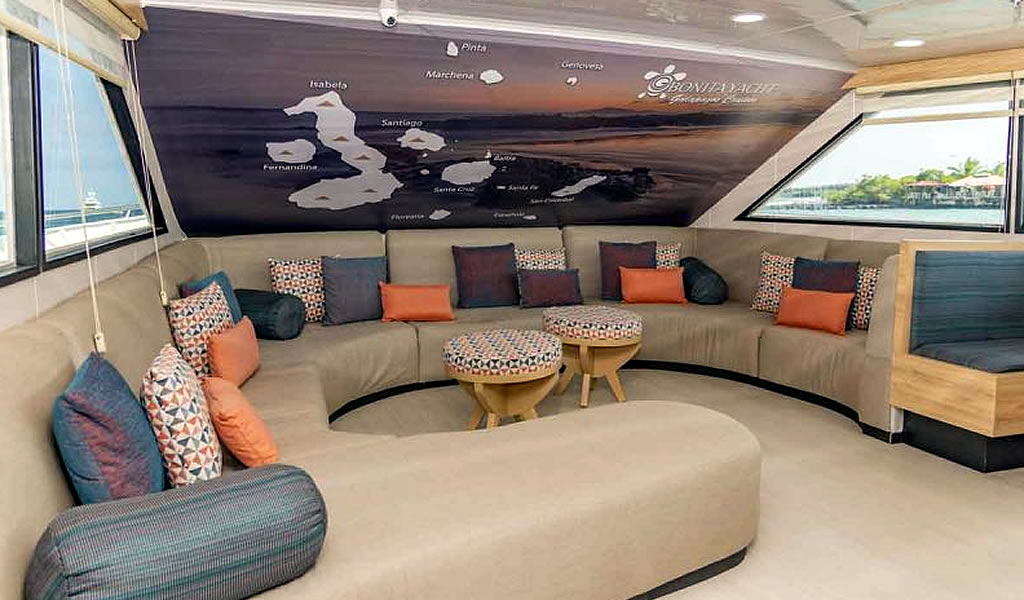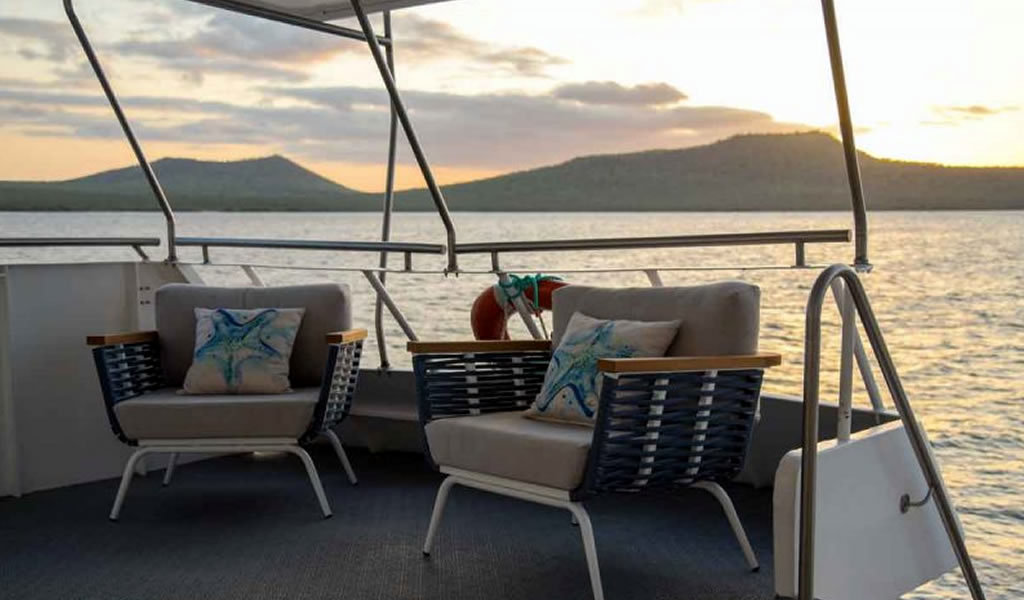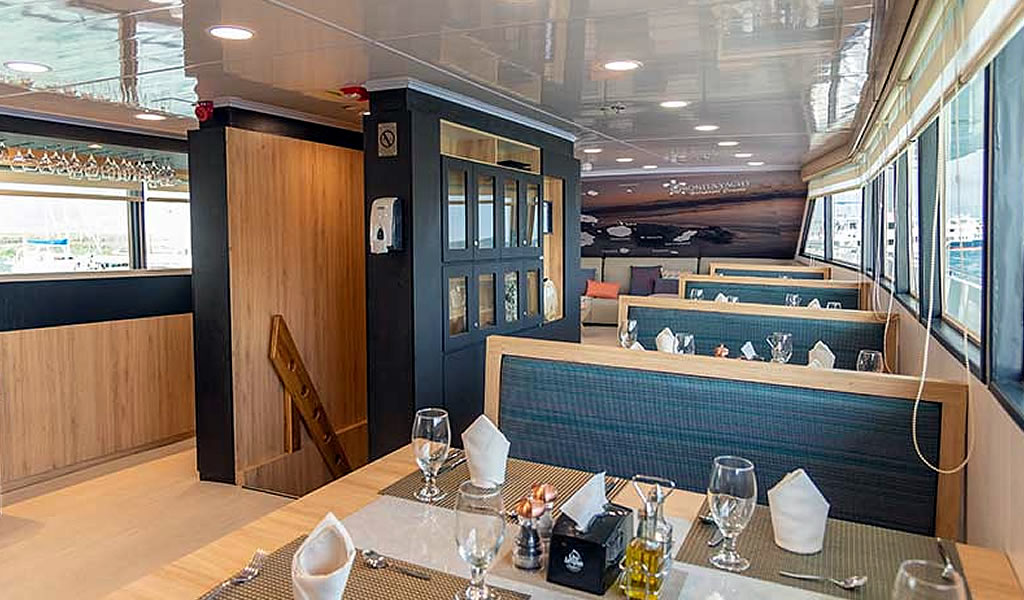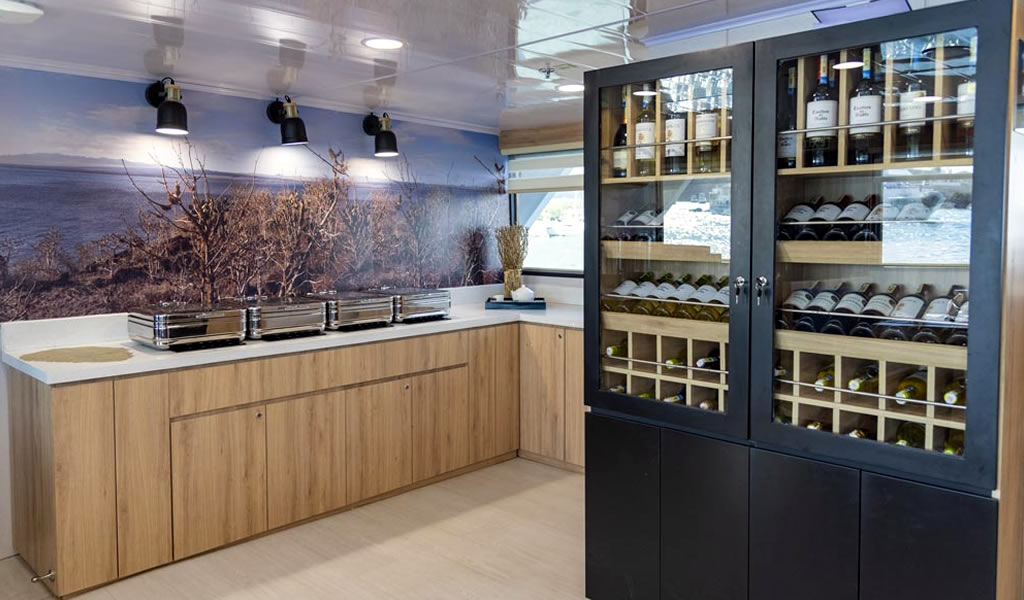Show Detailed Itinerary
Day 01 Am: Baltra Airport
Am: Arribo Al Aeropuerto De BaltraDeparture to the Galapagos Islands, arrival at Baltra airport, where our naturalist guide of the National Park will be waiting for you.
Pm: Dragon HillLocated in the northern coast of Santa Cruz, Dragon hill gets its name from the land iguanas that inhabit this area, the only location in the whole island of Santa Cruz where you can see this large species of reptiles. Thanks to a very successful breeding program, this population of land iguanas, which was in the brink of extinction during the 70’s and 80’s, has rapidly recovered. There is also a small salt water lagoon where we can often see flamingoes, ducks, stilts, sandpipers and other shorebirds.
Snorkel: After the hike, you will have the option to snorkel in shallow sheltered water where you will see large schools of surgeonfish and parrotfish, as well as reef sharks, rays and a large diversity of tropical fish.
Highlights: Galapagos land iguanas, Darwin finches, American flamingoes, white-cheeked pintails, Galapagos flycatchers, herons.
Trail: 2,2 km
Meals: Lunch, Dinner
Day 02
Am: Buccaneer Cove / Espumilla BeachThis site gets its name because it was used by pirates and buccaneers during the XVII and XVIII centuries as a place to hide and get freshwater and tortoises. The place is very scenic with beautiful cliffs and interesting rock formations. There is no trail, but here you will take a dinghy to look at wildlife from the small boats.
Snorkel: You can snorkel in a sheltered bay which is teaming with underwater wildlife including large schools of fish (angelfish, puffers, parrotfish, snappers, grunts…) but also reek sharks, sea lions and sea turtles.
Highlights: Boobies, herons, Galapagos fur seals, swallow-tailed gulls, Galapagos hawks.
Espumilla is a beautiful 1km (0,6 mi) long beach with rusty-brown sand, located in the northern coast of Santiago. It is surrounded by large mangrove trees and a very interesting native dry forest, which is home to Galapagos hawks but also a great diversity of finches, mockingbirds and doves. Don’t forget to check the salt pan, as during the rainy season there could be flamingoes and ducks.
Highlights: Bobbies, oystercatchers, herons, Galapagos mockingbirds, Darwin finches, Galapagos hawks.
Pm: Egas PortDespite its name, there is no “port” at Puerto Egas, but you might see a few remains of the last attempts to colonize the island during the 60’s. The trail goes along the coastline which is rich in wildlife, with marine iguanas basking in the sun everywhere, Galapagos sea lions, herons, oystercatchers and many shorebirds. At the end of the trail an area called “the grottos” is home for a small colony of the endemic Galapagos fur seal, much more difficult to see at close range than its cousin. As recently as 2019, land iguanas where re-introduced to the area, so look around for these impressive reptiles which where extinct from Santiago for over a century.
Snorkel: You can snorkel from the beach and explore an area of rocky bottoms which is excellent for fish, turtles and reef sharks. Often, sea lions are also present and are happy to interact with divers.
Highlights: Galapagos sea lions, Galapagos fur seals, oystercatchers, marine & land iguanas, Galapagos hawks, herons, shorebirds, Darwin finches, Galapagos doves.
Trail: 2,3 km
Meals: Breakfast, Lunch, Dinner
Day 03
Am: Am: Vicente Roca PointSurrounded by some of the tallest cliffs in the Galapagos, Vicente Roca point is a great location to observe spectacular landscapes and interesting volcanic features. There is no trail here but you will take a dinghy tour along the shore to get a closer view of pelicans, flightless cormorants, sea turtles, boobies, Galapagos fur seal and marine iguanas. The area is also known to be a good location for whales and dolphins.
Snorkel: Snorkel in the cove to look for sea turtles, penguins, sea lions, cormorants, rays and many different species of fish. Look for fan corals, sponges and other invertebrates growing on the walls.
Highlights: Marine iguanas, flightless cormorants, penguins, sea turtles, fur seals, Nazca & blue-footed boobies
Pm: Espinoza PointFernandina is the most active volcano on the islands, with regular eruptions every 3-5 years. This island is also one of the jewels of Galapagos due to the large number of animals that live on its shores. As soon as you disembark you can see hundreds of marine iguanas lounging carelessly in the sun, while the tide pools are the favorite place for the sea lions to play. Further on, Galapagos cormorants build their nests near the shore, not far from other species such as herons, oystercatchers and other shorebirds, while sparrow hawks often perch in mangroves in search of prey.
Snorkel: The nutrient-rich waters are the reason for the great diversity of species in this area, including penguins, cormorants, sea lions and many sea turtles. The abundance of algae makes this place the best place to see marine iguanas feeding underwater.
Attractions: Galapagos hawks, marine iguanas, cormorants, penguins, sea lions, turtles, herons, coastal birds, Zayapas crabs.
Trail: 1,6 km
Meals: Breakfast, Lunch, Dinner
Day 04
Am: Urbina BayThis place is known for the dramatic uplifting that happened here during the 1950’s. A large portion of the coast was pushed up, exposing many hectares of previously submerged land. Look carefully along the trail and you will find small shells and corals, a proof that the area was underwater more than sixty years ago. The trail will give the opportunity to see land iguanas and, during certain seasons, giant tortoises. Galapagos hawks nest in the area and are often seen flying or perched on the trees.
Snorkel: You can snorkel from the beach to see sea turtles, cormorants and penguins. Fish are also abundant in the area.
Highlights: Galapagos hawks, land iguanas, Galapagos hawks, Galapagos mockingbirds, Darwin finches, flycatchers.
Pm: Tagus CoveTagus cove is one of the places Charles Darwin visited during his exploration of the Galapagos islands. A trail will take you through a dry Palo Santo forests where you can see Darwin finches and mockingbirds. You will get great views of Darwin’s lake and the large volcanos of northern Isabela. A boat tour along the shore will give you chances to see penguins, cormorants, marine iguanas and a very unique species: the Galapagos martin, a small endemic bird which is one of the most endangered species on the island.
Snorkel: The nutrient-rich waters around Tagus Cove attracts a lot of sea turtles and a great diversity of fish, but also penguins, who feast on large schools of anchovies. It is common to see cormorants underwater as they chase fish through the reef.
Highlights: Galapagos hawks, marine iguanas, flightless cormorants, herons, penguins, sea turtles, sea stars.
Day 05
Am: Elizabeth BayElizabeth Bay is a beautiful sheltered bay surrounded by large mangroves and barren lava fields. There is no trail here so you will take a dinghy tour to explore many channels, pools and coves teeming with life. This is one of the best locations in the islands to see Galapagos penguins, but don’t expect to see thousands of them, as the entire population of the islands is only about 3.000 of them. Flightless cormorants also nest in the area and blue-footed boobies and pelicans often fish in these shallow and rich waters. Rays and sea turtles are also very abundant.
Highlights: Galapagos hawks, sea turtles, rays, Galapagos penguins, flightless cormorants, herons.
Pm: Punta MorenoThis is a place of stark contrasts, with vast lava fields that seem barren at first glance, and a rocky coastline teeming with animals. As you advance along the path, you will discover pools of brackish water that form true oases of life where you can see flamingos, ducks, gallinulas, and other aquatic birds. Near the coast it is common to find cormorants, penguins, pelicans and large marine iguanas.
Snorkel: Excellent place to swim with sea turtles and many species of fish. Look carefully through the algae and with luck you may see seahorses.
Attractions: Flamingos, gallinulas, penguins, marine iguanas, Darwin's finches, sea lions.
Trail: 1,6 km
Food: Breakfast, Lunch, Dinner
Day 06
Am: Charles Darwin StationThe Charles Darwin Station is a nonprofit organization which has been working for decades together with the Galapagos National Park to preserve the biodiversity of these unique islands. During this visit you will learn about the projects that both institutions carry together to protect the native species and eradicate the invasive ones which are threatening the Galapagos environment. One of the most important and emblematic projects has been reproducing giant tortoises in captivity. The visit is mostly outdoors in a beautiful dry native forest with giant cactus and many other interesting native plants. It is also a fantastic place to find several endemic Darwin finches, as well as flycatchers and mockingbirds.
Highlights: Galapagos giant tortoise & land iguanas breeding program, Darwin finches, Galapagos mockingbirds, Galapagos flycatchers, yellow warblers.
Pm: HighlandsEither if you do this visit starting from Baltra or from Puerto Ayora, a bus will take you to the highlands stopping along the way at one of the reserves to visit the lush highland forests where you will look for Galapagos Giant tortoises in their natural environment. This is the best place in the Galapagos to see these gentle giants (reaching over 300 kg / 600 pounds!) casually grazing and resting in freshwater ponds. This is also home for a great diversity of birds rarely found at the lowlands, including finches (tree, woodpecker and vegetarian finches), flycatchers and several species of water birds. You will visit a lava tunnel (depend on the itinerary) and learn how these extraordinary formations where created by ancient volcanic eruptions.
Highlights: Giant tortoises, Darwin finches, barn owls, white-cheeked pintails, Galapagos flycatchers, Lava tunnels.
Trail: 1-1,5 km
Meals: Lunch, Dinner
Day 07
Am: Twin CratersThe Twin Craters or also known as “Los Gemelos”, are located on the way to the Highlands of Santa Cruz Island. You will find them on both sides of the road leading from Puerto Ayora to Baltra. In fact, they are not real craters, they were created by the collapse of surface material in underground fissures and chambers. You will have a wonderful view of the local flora, like Scalesia plants. On this site it is also possible to observe the endemic short-ear owl.
Then, transfer to the airport to take your flight back to continental Ecuador.
Meals: Breakfast

